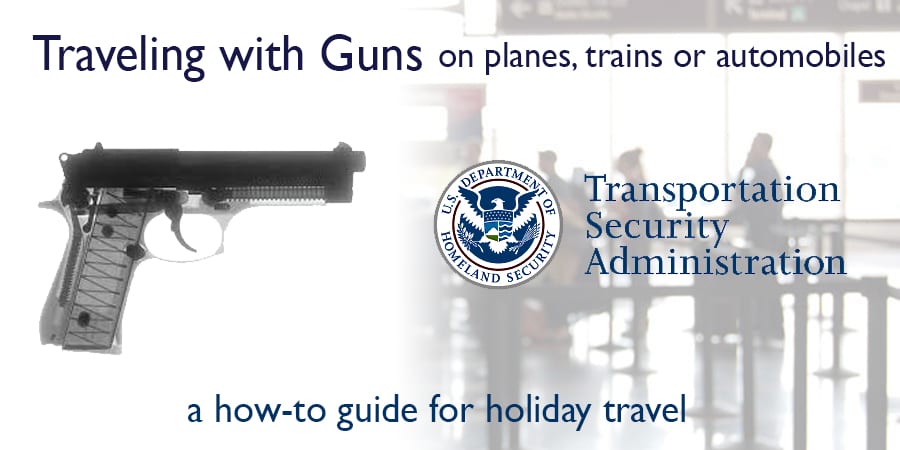
Thanksgiving just ended but Christmas will be here before we know it. That means a lot of us will once again be traveling long distances to be with family. The majority of us will be driving, but many will fly and some will take trains.
Because I think it’s important to be armed wherever you go, I’m going to cover how you can have your gun with you wherever you end up spending the holidays. And since most of us will be driving, let’s start there…
I happen to live in the state of Utah. Fortunately for me, I will be spending Christmas in the state of Utah too. Since Utah is a gun-friendly state, and because I have my concealed carry permit, I can carry the entire time while driving to my final destination.
But let’s say you happen to live in Virginia (where I used to live) and were driving to Pennsylvania for Christmas. To get to Pennsylvania from Virginia you may have to travel through the “gun-unfriendly” state of Maryland. In other words, you shouldn’t carry concealed and drive straight from Virginia to Pennsylvania, even if you have a permit.
What you need to do is have your gun unloaded, locked in a case, and in your trunk while driving through the state of Maryland. This means you have to pull over while still in Virginia, before you’ve crossed into Maryland and unload and lock up your gun appropriately. Once you enter the state of Pennsylvania you would be able to pull over and retrieve your gun and carry concealed once again, as long as you have a permit that has reciprocity with Pennsylvania.
Let me give you one final driving scenario…
Let’s say you were actually spending the holidays in a state that wasn’t gun friendly. For instance, you live in Nevada and were spending Christmas at a relative’s house in California. Well, you would travel to that relative’s house with the gun unloaded, locked up, and in the back of the car, just as I gave in the Maryland example above.
And since you were spending the holidays in California (and probably don’t have a California CCW) the gun would have to remain inside your relative’s house and you couldn’t take it anywhere with you while in California. When you are ready to go home, you’ll follow the same procedure to drive back as you did to drive there.
Now let’s talk about flying with guns. I’ve flown all over the United States to teach pistol and rifle courses and I’ve never had a problem checking my firearms. The first thing you need to do is to make sure you have a hard-side case. The plastic case that most guns come in when newly purchased will work just fine, as will a hard side combination case (see below.)

Before you head to the airport, unload your gun, put it in the hard-side case, make sure it’s locked, and then put it in the luggage you plan to check. Put your ammunition in a separate container, the cardboard box it came in is just fine, somewhere else in your checked luggage. Personally, I put my ammo on the bottom of my bag, then my clothes, then my gun inside its case, right on top so it’s easily accessible at the ticket counter.
Once you get to the airport you will go to the ticket agent and you will say to them the following words: “I need to declare a firearm and ammunition.” Make sure to use those words. You don’t want to say to the ticket agent, “I have a gun.”
Once you’ve declared your gun and any ammunition, the ticket agent will hand you a small card to sign. In short, this card says that you declare you are legally allowed to be in possession of said firearm and that the gun is unloaded and if any of this is not true you’ll be in big trouble.
After you sign and date the card, the ticket agent will likely have you do one of two things: When I fly Delta, they just tell me to open up my luggage and they put the card on top of my gun case. When I fly Southwest, they actually make me open the locked gun case and they put the card on top of the actual gun, then lock the case back up.
After the card is where it’s supposed to be and you have your tickets, the bags get checked and the gun (or guns) end up at the final destination. It’s easy to fly with your gun as long as you understand the rules, which are fairly simple. In fact, when I used to live in Virginia, I often flew out of Baltimore Washington International Airport, and even in the state of Maryland I had zero trouble checking my guns.
When it comes to traveling on trains, each company has it’s own policy. I’ll go over Amtrak since it’s one of the largest and most popular options. You are allowed to check a firearm on a train, just as if you were getting on an airplane. You must notify Amtrak 24 hours in advance of your departure that you will be checking a firearm.
You need to arrive at least 30 minutes before your train leaves and the firearm must be in a hard-side case, unloaded, and locked. When you get to the station you will declare a firearm and ammunition and you will have to sign a form just as you do with the airlines.
Remember, criminals don’t relax during the holidays. In fact, home invasions spike during the month of December. So wherever your travels take you, be sure you’re armed. It’s easy to do and won’t get you in any trouble as long as you follow the regulations of your chosen mode of transportation (and your final destination).


